Have you ever seen those little vases of braided bamboo stalks in the florist section of the supermarket and wondered if those partially submerged plants could survive in your aquarium? Despite myths to the contrary, they are safe for tanks with fish and invertebrates, so here are my tips on caring for Lucky Bamboo in aquariums.
What is Lucky Bamboo?
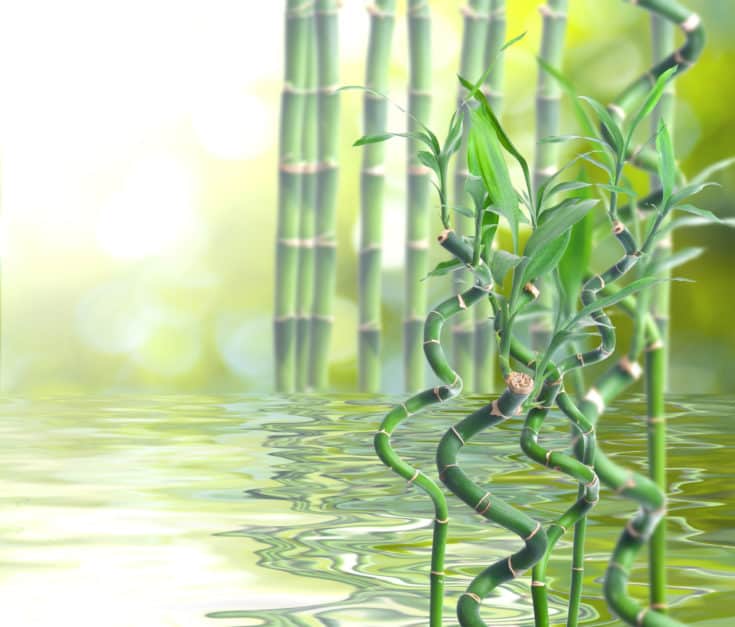
Lucky bamboo is a popular and common houseplant, but unlike many others, it’s very easy to care for and doesn’t need to be planted in soil: It can survive in just a few inches of water! The ironic thing about Lucky Bamboo (Dracaena sanderiana) is that it isn’t a true aquatic plant at all. It’s not even really a species of bamboo.
Difference Between Lucky Bamboo vs True Bamboo
How does Lucky Bamboo differ from the true Bamboos? True bamboo plants are relatives of the grass family, so they’re basically cousins to your lawn and food plants such as wheat, rice, and barley. There are over 1,000 species of bamboo in the world, and they are fast-growing and sometimes even invasive outdoor plants.
Lucky Bamboo is native to the Central African country of Cameroon and is a type of flowering lily. In the wild, this plant grows under the canopy in tropical forests and can survive seasonal flooding and dryer periods. It’s a hardy, tough plant that’s almost impossible to kill accidentally. But can you put this bamboo in a fish tank?
How To Grow Lucky Bamboo in an Aquarium or Fishbowl
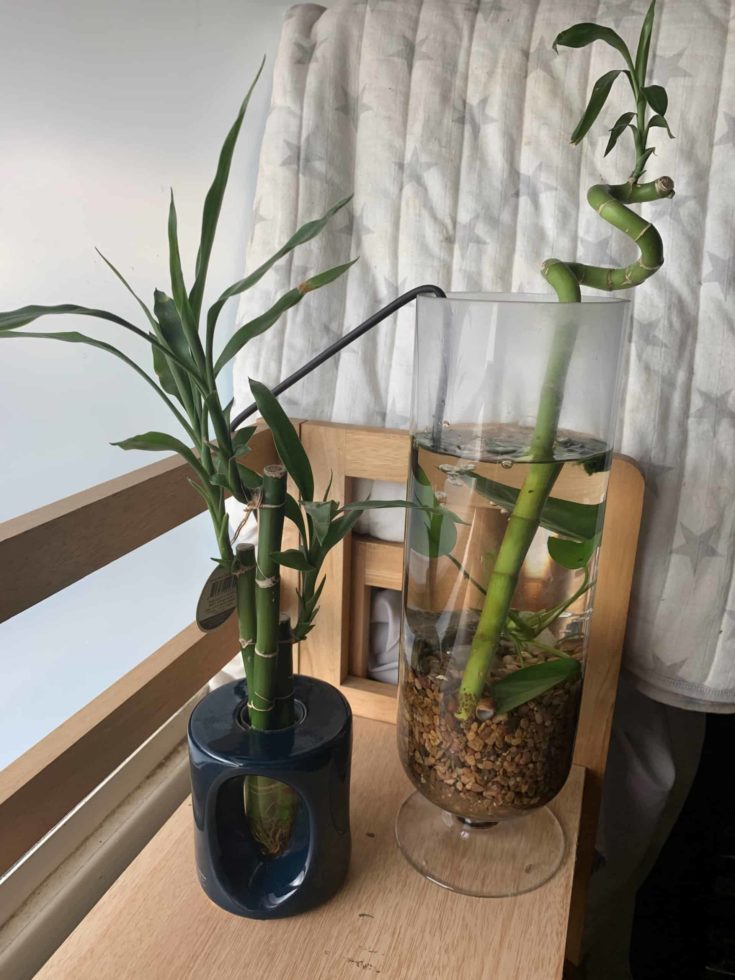
Lucky Bamboo is an ideal underwater plant for tanks of all sizes. It’s flexible in its habits and very easy to care for. Let’s talk about how to use this plant in your aquatic set-up.
Type of Water
Lucky bamboo is a freshwater plant and is not suitable for marine or brackish water aquariums. Their ideal water pH is 6.0 to 6.5, but they do well over a wider range.
They are not sensitive to water hardness. You may be able to use tap water for your bamboo aquarium, but it can also be problematic:
- Chlorine in the water can cause root stress, and extended exposure may slow the growth of the plant or cause the leaves to turn yellow.
- While you can use pre-conditioned (dechlorinated) tap water in a bamboo tank, you’ll also need to check your local fluoride levels.
- Fluoride is toxic to Lucky Bamboo, so if your tap water is fluoridated you may need to use bottled or home filtered water in your tank instead.
- While you can use pre-conditioned (dechlorinated) tap water in a bamboo tank, you’ll also need to check your local fluoride levels.
Water and/or Substrate Depth
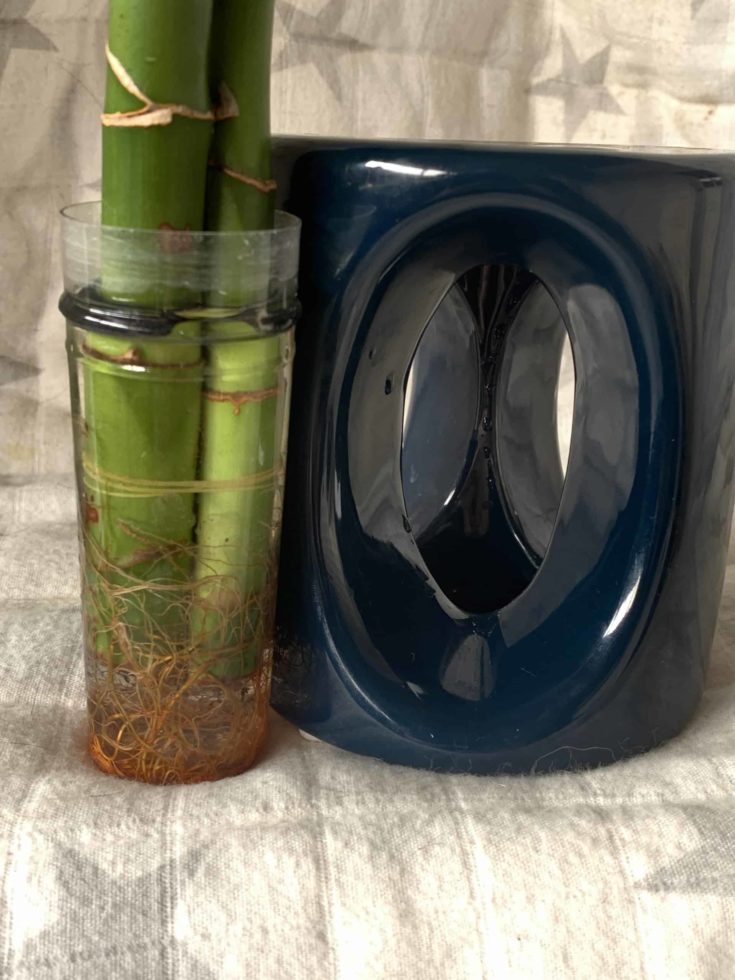
Does Lucky Bamboo need to be submerged entirely in water, or can the leaves be exposed to the air above your tank? You can sink the plant in a deep, portrait-style tank or let the bamboo stalks rise out of your fishbowl; as long as the roots are submerged, your plant should thrive either way!
- You’ll want to sink at least 2 to 3 inches of the root-end of the bamboo stalk under the water and ensure it remains covered.
- Lucky bamboo can also be planted up to 4-inches deep in your substrate to anchor it firmly in place.
- It does best with coarse gravel or pebble-based options that ensure plenty of water circulation to the root system.
- When planted in fine aquatic soils or sands, bamboo can suffer if the substrate compacts around the roots or develops hypoxic Dead Zones.
- Unlike true bamboo plants, Lucky Bamboo does not tolerate dry roots. Your plant will die if planted in soil that’s allowed to dry out or if the water evaporates from the area around its roots.
Lighting Needs
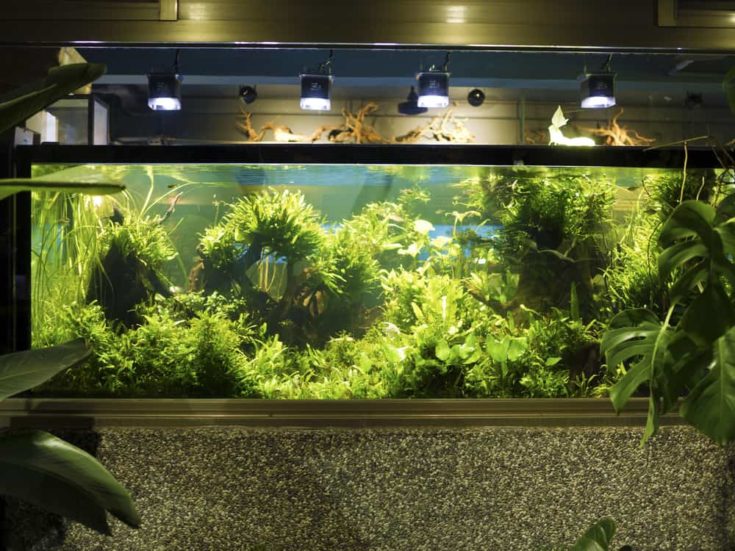
Lucky Bamboo couldn’t be simpler to grow, and it’s one of the easiest moderate-light aquarium plants to care for. All it needs is a few hours of bright, indirect light each day and your plant will do beautifully. It’s not a good option for tanks with LED light fixtures, however. Intense light causes the leaves to burn as they turn brown and die.
Fertilizer
While you can certainly use an aquarium-safe liquid fertilizer in a bamboo tank or place fertilizer tabs in the substrate they’re planted in, Lucky Bamboo isn’t a heavy feeder. You don’t have to add anything special to your tank to grow this small bamboo plant. The waste from your fish will likely supply plenty of nutrients!
Carbon Dioxide
Lucky bamboo uses carbon dioxide (CO2) produced by your fish and invertebrates as part of the process of photosynthesis. Since it’s not a fast-growing plant, you don’t have to use a CO2 diffuser in your tank to have beautiful aquatic bamboo.
While I’ll occasionally dose bamboo with a liquid carbon supplement, I’ve never bothered to use a diffuser in my bamboo tanks. As long as you have plenty of water circulation from an air stone or filtration system, it’s unlikely these easy-going plants will suffer from any nutrient deficiencies.
Benefits of Planting Lucky Bamboo in Your Tank
Besides providing a unique and lovely backdrop to your aquarium, Lucky Bamboo has other benefits. The roots create a home for the good aquatic bacteria, and many fish enjoy nibbling on the root tips growing from the stalks. Plants also release oxygen and use the waste and CO2 produced by your aquarium’s inhabitants.
Myths About Lucky Bamboo in Aquariums
There are many myths about growing these plants in aquariums, and a lot of misinformation on the internet about the dangers of using bamboo around fish or other aquatic pets. Let’s take a look at things people frequently get wrong about Lucky Bamboo!
1. Lucky Bamboo Releases Toxins into Your Aquarium Water
No, Lucky Bamboo does not release toxins into your tank water. But the myth is partially correct because planting true bamboo in an aquarium will cause these toxic spikes in ammonia that can kill your fish:
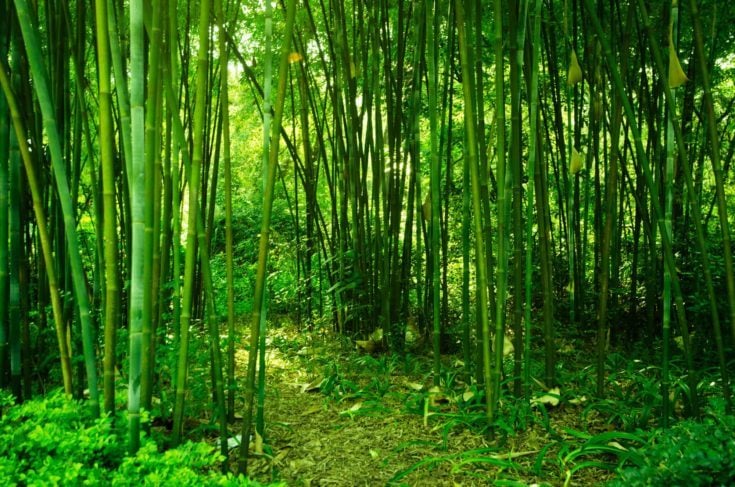
- True bamboo plants can’t grow if their roots are submerged
- Their roots decay underwater as the plant dies from suffocation
- This decay causes spikes in ammonia that overwhelm your filter and poison your water, leading to the death of your fish
2. You Can’t Fertilize Lucky Bamboo
I have no idea why this myth got started, but you absolutely can fertilize your Lucky Bamboo with an aquarium-safe liquid fertilizer or use tablets in the substrate to feed your plants. It’s not usually necessary, since these plants are not heavy feeders, but if you’re adding fertilizers for other plants your bamboo will also use them.
3. Bamboo Leaves Need to Grow Above the Waterline
No, you can grow Lucky Bamboo entirely underwater if you prefer. While these plants are usually sold with just the root-end in water, the leaves will continue to grow if you submerge them in your aquarium.
4. You Can Grow Lucky Bamboo in Your Filter
Yes, you can grow Lucky Bamboo in your HOB filter. Instead of using replaceable filter media, some people fill the box with bio balls or gravel and place the Lucky Bamboo roots in the filter compartment. With the cover off, the plant grows out the top of the HOB and stands above your aquarium and light fixture.
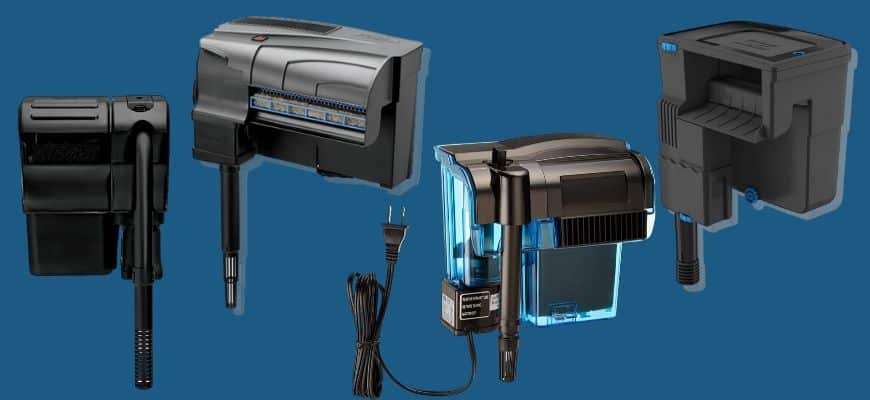
I’m not a fan of this technique myself, since the roots can’t absorb aquatic toxins as well as filter media. I also don’t like leaving my filter uncovered, since it allows too much dust and fur to enter the water. But it’s true, some people do grow Lucky Bamboo in their aquarium filters.
Frequently Asked Questions About Aquatic Bamboo Care
Here are some of the most frequently asked questions about using Lucky Bamboo in aquatic set-ups with other fish and invertebrates:
Q: How Long Can Lucky Bamboo Survive in Water?
A: Lucky Bamboo typically does well in water for about 1 to 3 years. After that, you may not see much new growth unless you transplant it into the soil. But it just depends. I’ve had one water-planted bamboo plant for over 5 years and it’s still going strong.
Q: How Fast Will My Lucky Bamboo Grow?
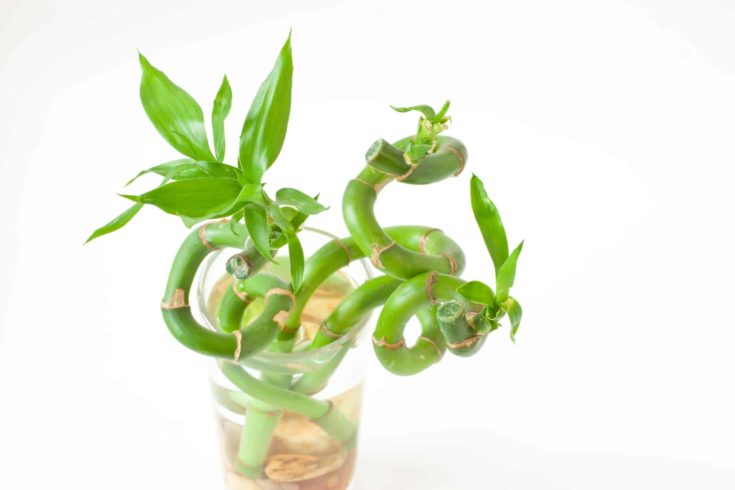
A: Lucky Bamboo is not a fast-growing species like the unrelated true bamboo plants. The rate of growth will depend on how much light the plant gets every day. Under moderate but indirect light, it typically grows as quickly as other houseplants. It grows more slowly when kept in low lighting conditions.
Q: Will My Lucky Bamboo Give Off Oxygen?
A: Yes, Lucky Bamboo, like all plants, gives off oxygen as part of the process of photosynthesis. Most of the oxygen is released from the leaves, so if your plant is totally underwater it will produce oxygen that your fish and invertebrates can use.
Conclusion
Have you kept a bamboo plant with betta fish or in your shrimp aquarium? We’d love to hear about your experiences with this lovely and easy-to-grow species! Tell us all about your bamboo tank in the comments, or share a picture with us on our social media pages! Lucky Bamboo is a great option for first-time aquascapers and makes a beautiful addition to nearly any freshwater set-up.
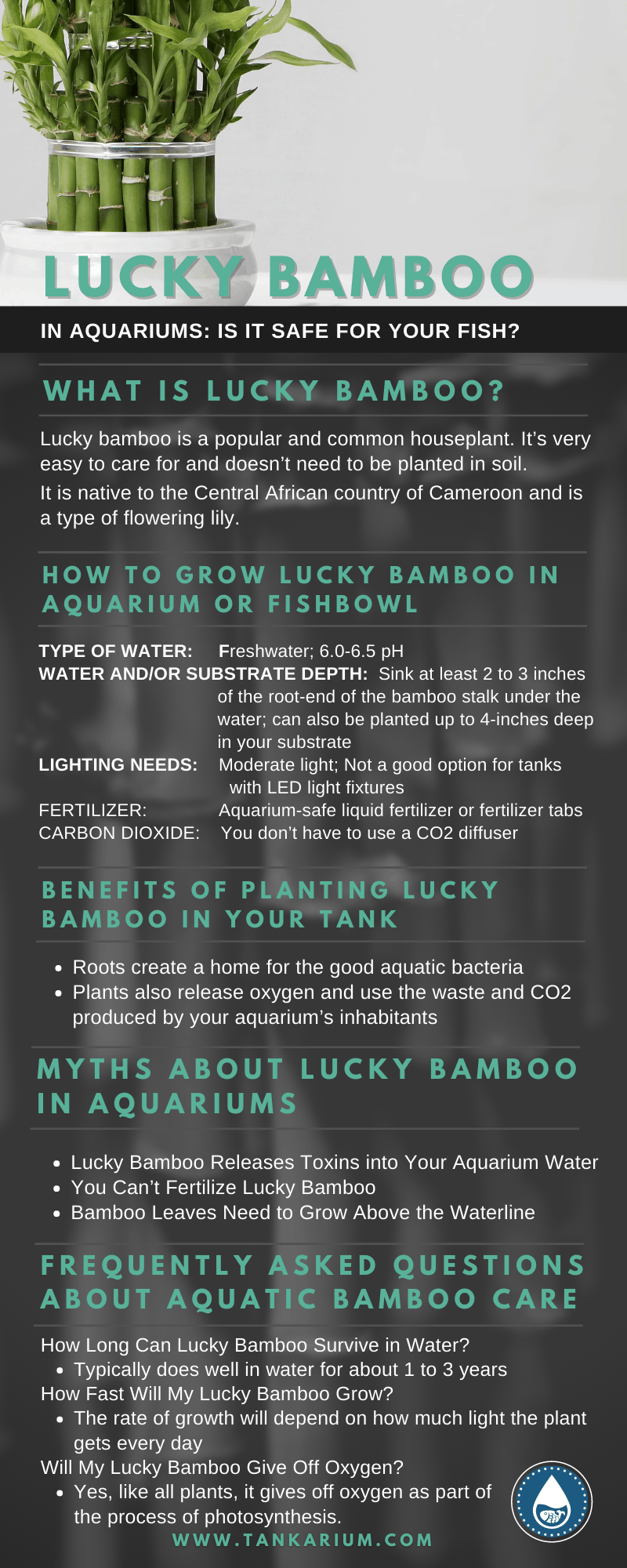
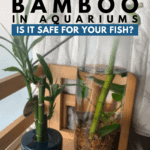
Hi, I had 12 lucky bamboos each of 2.5 feet hight, I placed them im my aquarium with only the stems being submerged upto 2 feet of water. Slowly each and every stem turned yellow and soft. Why is this happening. My Ammonia in the tank is zero, my nitrites are zero my nitrates are also zero and i change 30% water every 10 days.
Thanks.
Are you sure you had lucky bamboo and not authentic bamboo? That may be what’s going on. Authentic bamboo won’t survive and will start to rot
If your nitrates are zero, you’ll have a tough time growing any plants! They need nitrogen from somewhere.
I bought a LB bundle of three for my betta and two serpae tetra 5 gallon tank. One whole stem, and the leaves throughout the three got yellow after moving it from a location with direct sunlight, to one with General indirect sunlight. After about a week the yellowing started. I had it for months in the location with direct sun. So idk what is causing it. I got rid the one yellowed softened stem, but some leaves in the remaining two stems are still yellowing, and all I can do is just wait and see.
I am so thankful I found Tankarium. I have 4 Lucky Bamboo plants. 2 of them I have had a little over a year when I set up my first aquarium. I always heard they could not be fully submerged. The poor things have survived all the trials and errors of my learning to have a planted aquarium.
it seems there is many different types of lucky bamboo, even labeled as Dracaena Sanderiana. i bought some yesterday at the pet store with that name on the back and “white ribbon semi-aquatic plant” on the front of the topfin tube. looks like some sort of houseplant my mom used to grow when i was a kid. also says it grows 8-24″. keep getting all kinds of conflicting information about this plant. ive had “lucky bamboo” a few times before. even ones over 2ft tall stalks cut, which i placed in a few aquariums, with little long-term success. the fully submerged one, as i recall, didnt make it long at all, prompting the use of the long ones with the leaves above the waterline. they seemed to do well for a while, but i dont think they made 6mo before dying off. maybe it was short alaska days, not in direct light, or maybe the roots were chewed up by the fish, who knows, but im giving these white stripes a go. came with 3 small stocks, so i can try different levels of submerged for a while, then maybe do some training, like at the store if the stalks develop